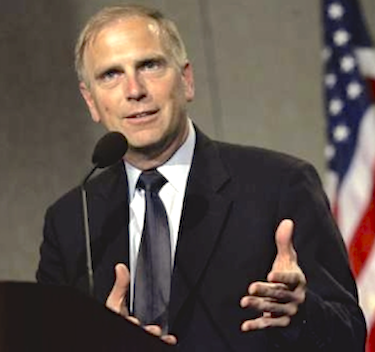
Rich Lechner is tasked with defining IBM's sourcing strategy (click to access his new research paper)
When you have over $100 billion in software, services and systems revenues and 440,000 staff worldwide, what can be simpler than running sourcing engagements for clients? Meet the man tasked with formulating a sourcing strategy for the firm: Rich Lechner, another one of these tech guys who should probably have become an industry analyst after 10 years of writing code, but somehow found himself piecing together the many facets of the world largest computing company to help devise this roadmap. We were fortunate enough to drag Rich away from his electric powered Tesla to spend a few minutes sharing his experiences with us from over three decades with Big Blue…
Phil Fersht, CEO HfS Research: Rich, great to have you talk to our readers today. You’ve been in IBM for over 30 years – did you ever expect to stay at one company for so long.. and how have you winded up doing what you’re doing today?
Rich Lechner, Vice Business & IT Services Marketing, IBM: First of all thanks for having me. It’s hard to believe it’s been that long. I will say that I feel like I’ve worked in many different parts of the industry but had the luxury of working for one great company. In the sense that I started out as a microprogrammer working on ATM’s and check processing machines and then went into a range of software development, strategy and sales roles for mainframes, OS/2, distributed systems management, Linux and eBusiness. I then moved to the hardware part of our business where I had the privilege of leading sales and marketing for mainframes for several years globally as well as working in our storage business. I then had responsibility for IBM’s broad portfolio of sustainability capabilities including green datacenters, water management, supply chain optimization, smarter traffic or smart buildings. And then finally coming to services. The common theme has been leveraging technology and innovation to address real world challenges and bringing differentiated value to clients.
Phil: In your recent research study “Why Partnering Strategies Matter” (HfS readers can download their copy here), where you surveyed 1350 participants, you talk about sourcing motivations and how they’ve shifted and why sourcing strategies need to shift with them. Can you expand on this some more?
Rich: As a leader in business and IT services, IBM works with many clients around the world and increasingly we were encountering customers who were looking not just to shed cost or to outsource some component of their environment, whether it be infrastructure, process or application, but rather increasingly they were also looking to acquire capabilities to address some need that they have. In many cases these needs were driven by the desire to harness important forces like social, mobile or big data in order to fuel growth and drive market expansion. And so in seeing that in our own engagements, we commissioned an extensive piece of research with a third party to assess partner strategies. The survey involved clients who had experience in outsourcing some element of their environment and there was broad participation across geographies, industries, and customer size. What we found was that clients were, in fact, increasingly looking to acquire capabilities that mattered most and not just to outsource a non-critical piece of their business for cost or efficiency benefits. And that those organizations who were being successful at doing that were seeing significant financial benefits of their business. They were also behaving significantly different in terms of the objectives they were setting for the partnership, the capabilities they were looking for in their partners, and the way they were executing the relationships.
Phil: You talk a lot about optimizers and innovators as contrasting partnering strategies. What do you mean by these terminologies and why are they different?
Rich: The study focused on clients who had experience outsourcing some element of their environment – in fact they could identify over 80 discrete elements of their infrastructure or set of applications and processes. One dimension of measured how broadly they’re outsourcing or leveraging partners. The second dimension was what was their primary motivation: was it primarily for cost take out and operational efficiency? Those who cited that as their primary reason we characterized it as “optimizers”. “Innovators” were those clients who said that their primary objective in developing a sourcing partnership was to achieve a business outcome; to gain access to innovation; for assistance in harnessing some new technology like social or mobile; were looking to expand globally; , or who were looking for a partner could infuse a culture of innovation into their organization. It is important to note that across all segments cost takeout and efficiency were important. But the relative priority varied between the innovators and optimizers and what the innovators did with the cost savings was significantly different in that they chose to not just throw those savings to the bottom line, but they were consciously leveraging efficiency to fund innovation in growth in other parts of infrastructure.
Perhaps most interesting was that the research showed that those clients who were broadly partnering for innovation had substantially better financial performance relative to those who were partnering in a very narrow fashion with a primary focus on cost optimization. The ‘ienterprise innovators’ saw 2x the revenue growth and 5x the profit growth compared to the ‘focused optimizers’
Phil: Rich, in terms of enterprises achieving measurable business outcomes from sourcing, I was reading about how metrics have been tied more effectively to outcomes in your paper. Did you learn more about how sourcing can improve a company’s access to critical data that they didn’t have before?
Rich: Phil, we found markedly different behaviors between the optimizers and the innovators. The innovators were looking for business outcomes beyond operational efficiency and they were far more likely to to define metrics that were directly tied to business outcomes. So for a retailer it might be the revenue per store or inventory turns. It might be subscriber retention rate for a telco or bed utilization for a hospital. So, the metrics for the partnership were very outcome based and by doing that, these innovators were also finding that to achieve those kinds of outcomes, they had to look more holistically. They needed data, or operational data, and they had to be able to link the financial drivers to the specific key process indicators and metrics, business metrics, and then needed to be able to aligning the relevant elements of their business and IT environments, the infrastructure components, the applications, the processes across those businesses that affected those outcomes. And then to develop a partnering strategy that allowed them to affect those in an integrated way.
Phil: You also talk a lot about integrated governance. I would love to hear a bit more about your thoughts here – we’re obviously looking a lot at evolving global business services frameworks at HfS. Do you think there is something unique evolving here, or is this more lipstick on the same old pig?
Rich: I think there is significant evolution with the governance model required to meet the expectations of the innovators. If you think about traditional focus on operational governance, you’re really focused on service quality and continuous improvement. Of course that’s foundational and will always matter. As does the tactical and functional governance focused on some of the business relationship and fulfillment against contracting services. But – as you begin to move into the space of business outcomes and partnerships premised upon outcomes then there is an additional need for strategic government that’s really focused on the alignment of the business strategy in the transformation of a client’s business. This to me is incremental to the governance model that most clients are putting into place as they form a relationship with their partners or their outsourcing vendors.
Phil: Rich, not many people have been as close to the technology and service model shifts as you have really over three decades. What’s really different today? I mean, are we seeing similar inflection points than the ones we saw in the 80’s and the 90’s… or do you think things have really moved on in the last few years?
Rich: I think, in some regards, we’re seeing many of the same trends continue, but the emergence of several key forces: big data, the instrumentation of everything, the ability to analyze in real time all aspects of your interaction with your clients or of some of your business. The expectations of end consumers, based on the emergence of things like social and mobile. And Cloud as not only an important technology, but acting as an accelerator to the adoption of services. If you think back to client server computing two decades ago, it changed the way that IT capabilities were acquired by organizations. Prior to the emergence of client server, computing capability was sort of the exclusive domain of the IT organization, but now departments were able to acquire servers and storage and pc’s to perform critical business functions independently and it fundamentally changed the way that IT was acquired and applied inside business. Cloud is having the same sort of transformative affect. Because it’s allowing any individual or organization to acquire capability as a service, whether it be a process, an application or a bit of infrastructure as a service. Those forces coming together are creating this opportunity for significant transformation, but increasingly clients realize that they don’t have all the capabilities they need to address these issues or the opportunities that these forces present. And so what’s really changed is the acceleration of some of these traditional trends with these new forces.
Phil: Ok, so try and look out ten years from now… What do you think the world of sourcing is going to look like when we peer that far into the future based on everything you have lived through over the last few years?
Rich: I noticed that said “sourcing” which is great, because I think the idea of taking the “out” out of outsourcing will occur very rapidly and in fact it is already occurring. What I mean by that is that it will become much more prevalent for companies looking to acquire or source a key capability that they lack as opposed to shedding something that is noncore. And we are seeing that occur already and that will happen very rapidly. Secondly, I would say I think if you look ten years out, increasingly today we talk about infrastructure as a service or software as a service I think that you will see everything as a service. The idea of any capability, whether it be marketing insights or compute capacity or real time analytics of consumer behavior or what have you as a service will be the norm. Everything as a service will be what people will be sourcing. Again whether it be infrastructure, or application or processes, or industry insights, or marketplace insights, or technology.
Phil: Rich, it’s has been very refreshing to hear from somebody like you who has been so close to the industry for so long, so I do thank you for your time, and I look forward to sharing your thoughts very much with our readers.
Rich: Thank You, Phil – a pleasure to share some thoughts and I hope your readers find the time to reads our new research paper.
Rich Lechner (picture above) is Vice President for IBM’s Business and IT Services Sourcing.
Posted in : Business Process Outsourcing (BPO), Cloud Computing, Global Business Services, HfSResearch.com Homepage, IT Outsourcing / IT Services, kpo-analytics, Outsourcing Heros, SaaS, PaaS, IaaS and BPaaS, Security and Risk, smac-and-big-data, sourcing-change








[…] Welcome to the Lechner lectures: Why partnering strategies matter Horses for Sources Meet the man tasked with formulating a sourcing strategy for the firm: Rich Lechner, another one of these tech guys who should probably have become an industry… […]